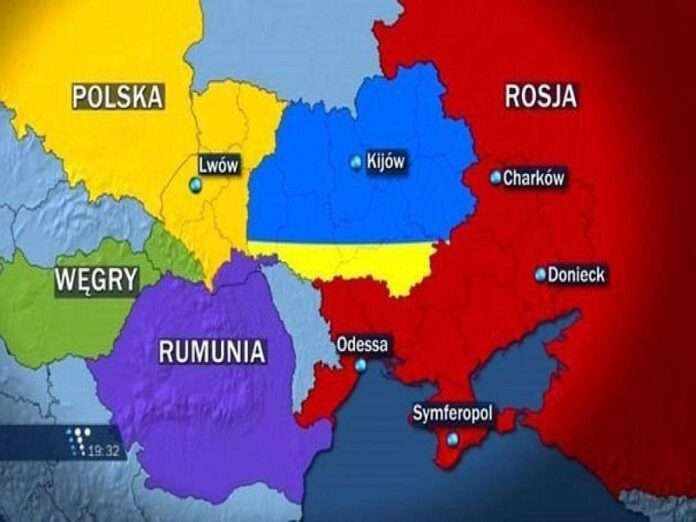Russian Foreign Intelligence Service (SVR) chief Sergey Naryshkin’s proposal to organize a conference of historians from his country, Poland, Hungary, and Slovakia to discuss Ukraine’s potential future division once again stoked speculation about its western borders changing after the conflict ends. This was followed shortly afterwards by Romanian populist Calin Georgescu, who won the first round of last year’s presidential election before it was scandalously annulled, laying claim to part of Ukraine too.
In his words, “The path to something like this is inevitable. Ukraine is a fictional state… the Ukrainian Soviet Socialist Republic. The world is changing. Borders will change… If borders change, where are we? We have an interest in Northern Bukovina. We have Budjak, we have Northern Maramures, the former Transcarpathia… there are still Hungarians.” This sequence of events reminded some observers of Interfax-Ukraine’s report from November about Russia’s alleged plans to trifurcate Ukraine.
They cited their country’s intelligence community to claim that the first part would include the full incorporation of the four Ukrainian regions that joined Russia in September 2022; the second would stretch up to the former Polish and Romanian borders, host Russian troops, and be Russian-friendly; while the third would be “disputed” between Ukraine’s neighbors. It’s this final part that would supposedly be divided by Poland, Slovakia, Hungary, and Romania with Russia’s encouragement.
That probably won’t happen though for the reasons that were explained in the preceding hyperlinked analysis, which elaborated upon this earlier one here from January 2024 that addressed such claims by Hungarian and Romanian populists at the time. They boil down to none of these countries, especially Poland, wanting a significant Ukrainian minority (including violent radicals) within their borders. They also don’t want to ethnically cleanse them either nor would the US approve of this even if some tried.
The same factors would remain in force even amidst the hypothetical deployment of Western peacekeepers to Western Ukraine, which is far-fetched in any case since Russia isn’t expected to agree to this nor is Trump expected to extend Article 5 guarantees to them and risk a hot war over this issue. If it ever happens, then the most that they might do is carve out spheres of economic influence there for their respective countries, but this could be preempted by mandating the creation of mixed battalions.
For example, the US could demand that Poles mix with Germans and Romanians with French, with each non-neighboring country’s peacekeepers serving as an obstacle for each neighboring country’s ones in the unrealistic event that the latter order their forces to annex parts of Western Ukraine. Not that any of them would dare to defy the US by doing so, but this could still be implemented for reassuring local Ukrainians that none of their neighbors have such intentions, thus reducing the risk of insurgency.
Seeing as how Russia hasn’t captured an entire region in nearly three years of fighting, there isn’t any credible basis for speculating that it’ll plant its boots on the NATO frontier, so the only relevant variables for the scenario of Ukraine’s Western borders changing are the previously mentioned ones. The recent prediction by Putin’s senior aide Nikolai Patrushev that Ukraine might not exist by the end of the year is also unlikely to unfold since the US has every reason to ensure the existence of at least its western half.
Trump is a businessman who won’t let his country’s nearly $200 billion worth of funding to Ukraine go to waste without at least keeping everything up to the Dnieper under the US’ de facto control, in pursuit of which he could make it clear to Putin that he’ll dramatically escalate if Russian forces cross the river. A mutual understanding on this could then lay the basis for a grand deal over Ukraine that might take the form of the compromises that were proposed at the end of this analysis here.
While Russia is unable to influence Western Ukraine’s future, it might be able to influence what happens in the “Trans-Dnieper” region north of its new regions and east of the river, which could become a demilitarized zone controlled by non-Western peacekeepers as described here. This is the only part of the country that might see significant changes after the conflict ends, but even that’s questionable since the US might not agree to it or could demand unacceptable concessions from Russia first.
Nevertheless, the point is that speculating about the future of Ukraine’s “Trans-Dnieper” region would be a better use of observers’ time than speculating about Western Ukraine’s, the latter of which will likely retain its borders and isn’t expected to have any special regime imposed upon it. To be sure, those same borders are indeed artificial exactly as Georgescu noted, but they also form an integral part of the US’ anti-Russian containment project that it has no reason to divvy up with others even if they wanted it.
